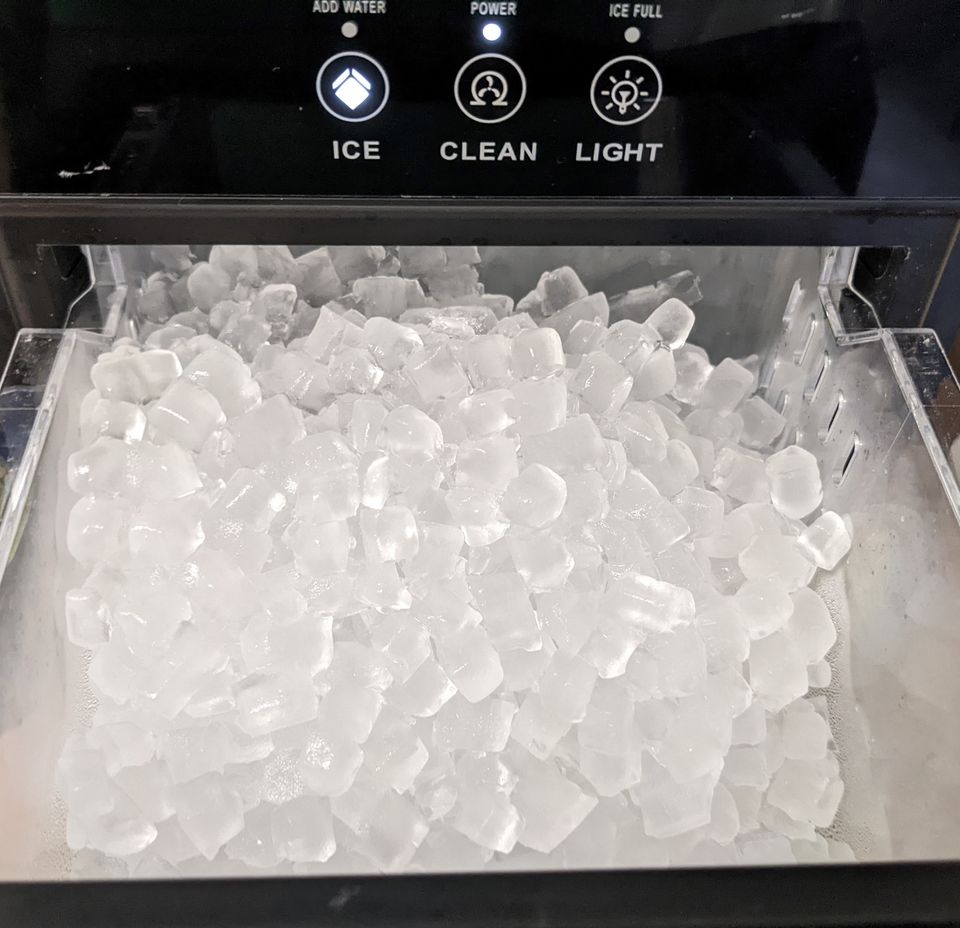Background
Currently I do not have a regenerator ice maker, and have no way to replace that appliance. This led me to a search for countertop units that could fulfill the same role.
As the "Insignia™ - 44 Lb. Portable Nugget Icemaker with Auto Shut-Off - Stainless steel" is the only ice maker I have ever owned, this review is focused on the features/problems of the unit without comparison to other products.
Overview
I considered several products for my ice maker purchase, and eventually settled on the "Insignia™ - 44 Lb. Portable Nugget Icemaker with Auto Shut-Off - Stainless steel". From what I was able to determine, ice makers fall into 3 main categories:
- "Bullet" style ice makers that create ice by plunging cold prongs into the water reservoir. The ice created here is probably most familiar to you from air travel, and have a vague 'bullet' shape and hole in the center.
- "Nugget" ice makers like this one, which function by compressing ice to give it a crunchy, chewable texture and a clear appearance. These are usually a bit more expensive than the bullet ice makers, and produce ice more slowly.
- "Clear" ice makers, that have water flow over a refrigerated tray that then pops out ice, but where you might have to break apart the ice after it's ejected from the tray.
- Ice makers that occur in a freezer that already has a low enough ambient temperature to create ice, like you would find in a normal refrigerator / freezer unit.
Functionality
Design
The Insignia ice maker is designed to constantly make new ice while the ice in the tray is melting, "recycling" the water. If you've looked at the variety of ice makers available already you've most likely noticed most countertop ("portable") ice makers work like this.
There are a few exceptions, such as this Edgestar Ice Maker that keep the ice in a 'freezer' compartment and work by having an ice maker you'd find in a typical fridge/freezer combination in a mini-freezer. However, I found a number of complaints that frost quickly jams the ice maker. The Edgestar also requires a water connection which may just not be viable for you, and wasn't for me so I did not consider it further.
The Ice
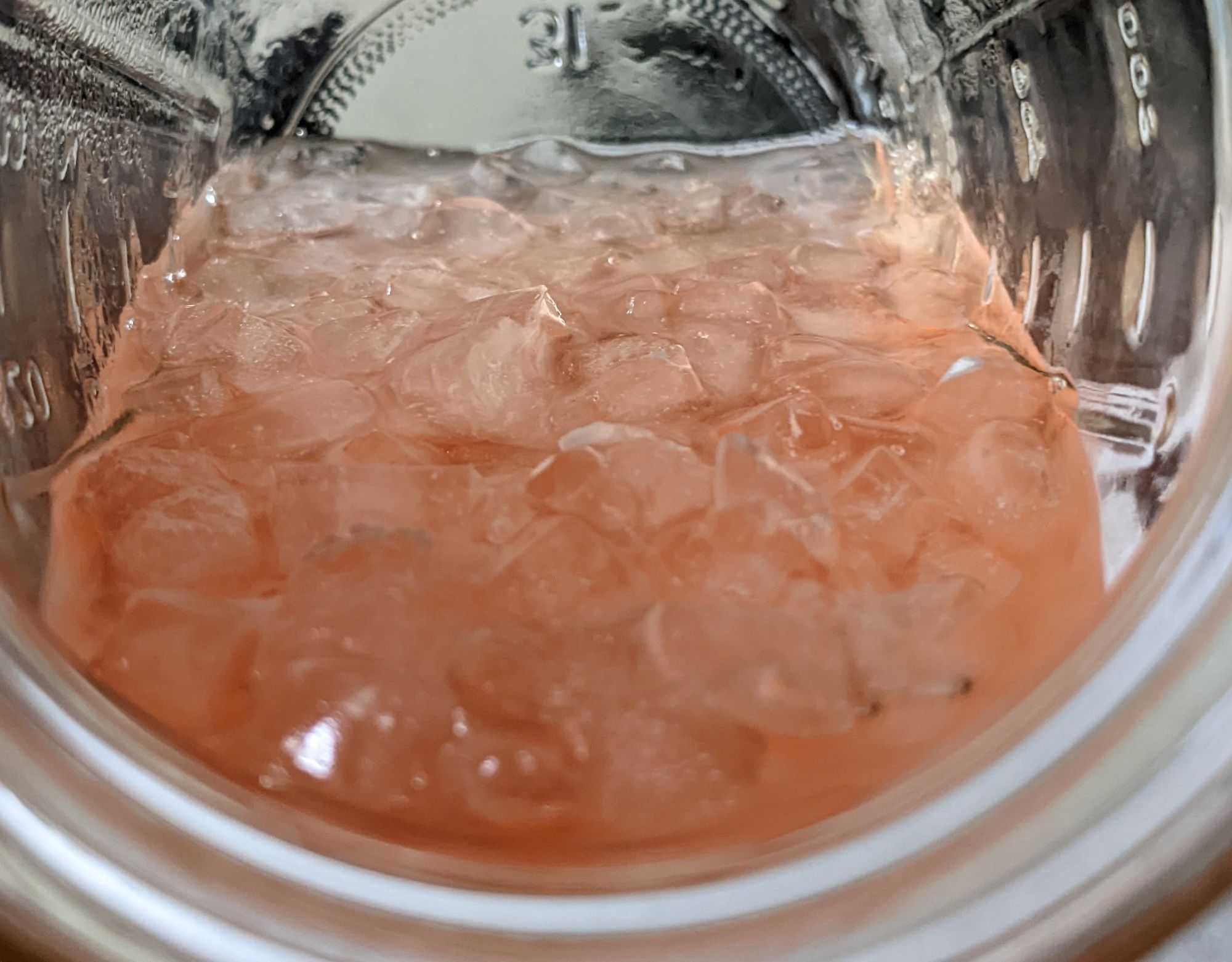
I've come across a few claims for "nugget ice", them being; (1) The ice is chewable, (2) The ice melts slower, (3) The ice takes on the flavor of the drink. Let's address them:
- The ice from the Insignia is chewable, though I'm not sure how it falls in line with "hospital"/sonic Ice or ice from the GE Opal series as I've never had it, however it is more chewable than ice you would make in a freezer. If you've never had it before think of it like an ice cube that's had some time to melt that you can easily crush it with your teeth.
- There are claims that the "ice melts slower", which I haven't found to be true. I've seen this claim generally stated. Slower than what? Ice cubes, spheres, large squares? You may be aware, but the larger the ice cube (and smaller the amount of surface area exposed to liquid) the longer the ice will take to melt and vice versa. I finally found the origin of this comparison, nugget ice will melt slower than shaved ice, which you would typically find used in mixed drink/cocktails. I haven't done any specific tests to this end, but I would expect nugget ice to melt faster than an equivalent temperature ice cube as it exposes more ice to the liquid than the cube does.
- I haven't found the ice to take on the flavor of the drink at all. I've tried nugget ice with cocktails, lemonade, etc... by having the refreshment and trying the ice after and it always just tasted like ice. As stated before, I can't compare this directly to hospital/sonic ice so it may be possible for those systems. However, for the Insignia, I wouldn't expect the ice to take on the flavor of the drink.
Ice temperature
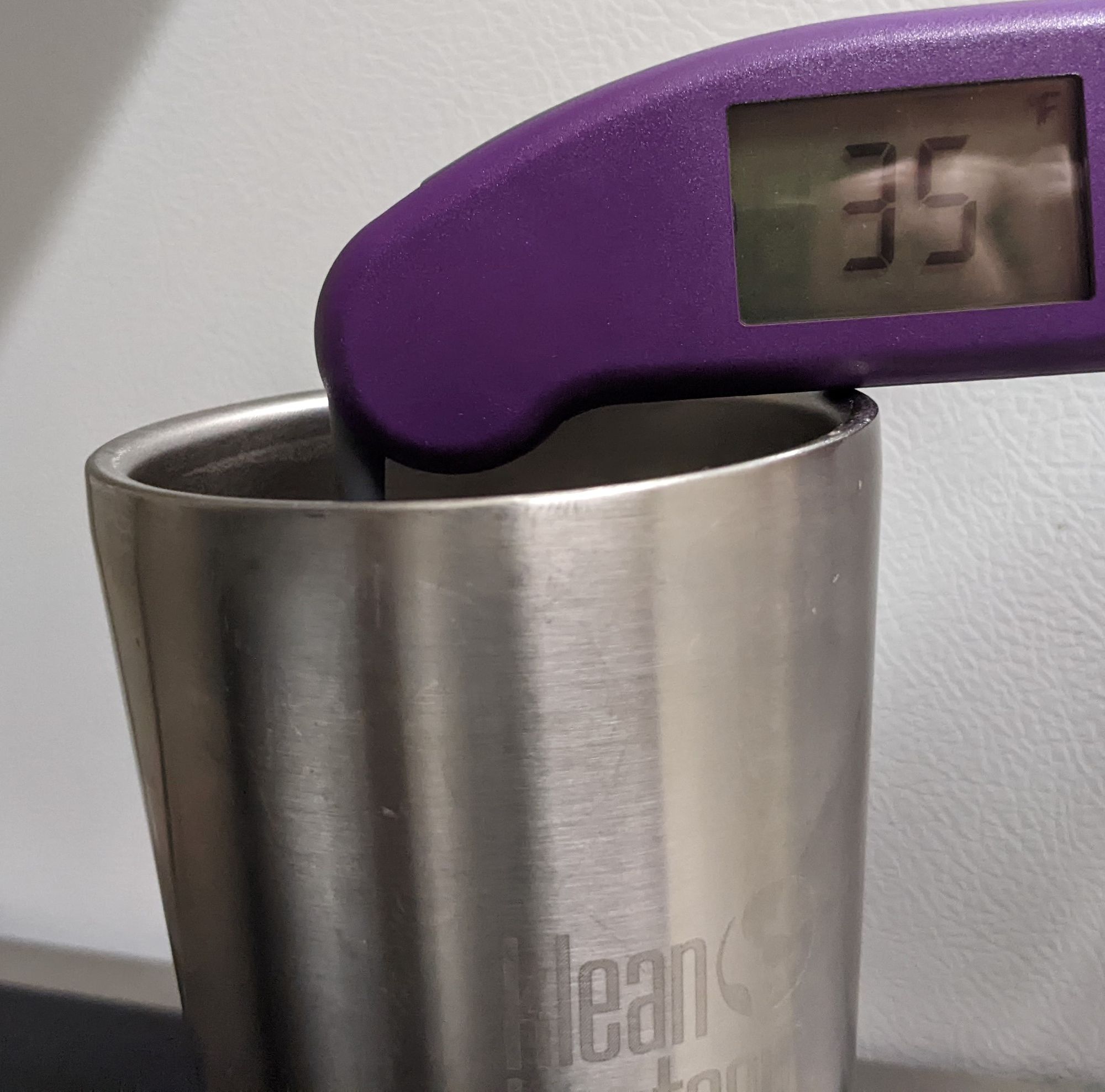
As the ice is always melting, it won't be as cold as ice you would normally get from the freezer. Functionally, I tested this with an insulated tumbler of water with both nugget ice and freezer ice as shown above.Using this test I found that with the nugget ice the water reached 35 °F (1.67 °C). With the same test, using ice from the freezer the water reached 34 °F (1.11 °C). Obviously not a lot of difference in performance here. The only consideration I would give both methods is that per mass of ice, ice from the freezer will be able to cool more water than an equivalent mass of nugget ice as the freezer ice will be at a lower temperature. However, it's worth noting that most of the cooling potential of ice is when it switches the state of matter (solid -> liquid), which the nugget ice will provide you.
Cleaning & Maintenance
Water in the ice maker is held in 2 compartments, the "lower" compartment which is below where the ice is held and you fill with fresh water, and a mystical "upper" compartment that the water is pumped from the lower reservoir to. Unfortunately, there is no way for you to access the upper compartment to physically clean it so you'll need to rely on the "clean" button that recirculates water through the appliance. You drain both compartments using the silicone tubing on the back of the unit into either a sink or large bowl to collect the waste water.
The user manual suggests running a cleaning cycle every 3 days:
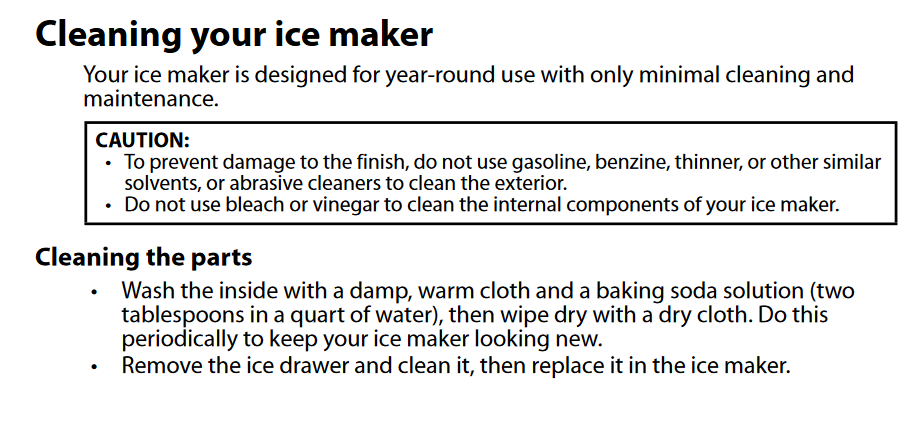
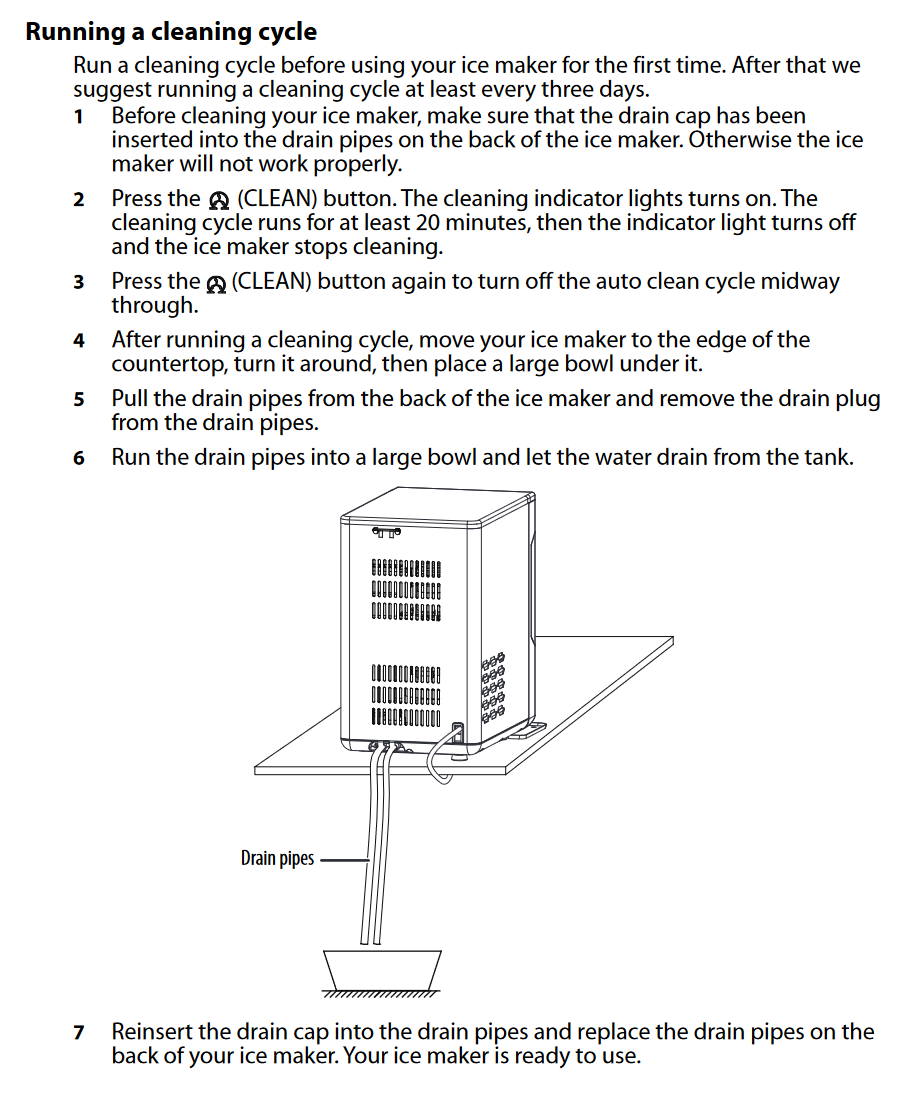
However it's not particularly clear with what, at the start it says to wipe down the inside with a baking soda solution, but it never elaborates if that is what you should be using when running the cleaning cycle. In the caution statement the manual also states to not use bleach or vinegar, and doesn't expand on if that includes diluting either and using that solution. In terms of longevity of the appliance the most conservative approach would be to just use tap water for the cleaning cycle, but personally I don't think that's sufficient to clean the upper compartment via recirculation alone as there is no way to wipe it clean.
So far I've been making the diluted baking soda mixture, running the cleaning cycle, then draining the ice maker and running another cleaning cycle with tap water to remove any baking soda that may have been left over. If it starts getting dirty I plan to try hydrogen peroxide or a very dilute bleach solution and assuming they were warning against using undiluted bleach.
In contrast the GE Opal line of ice makers is much clearer when it comes to cleaning, and does suggest that you use a dilute bleach solution and it also suggests cleaning once a week, not every 3 days.
If you follow the user manual to the letter, the ice maker does require a good bit of maintenance. It recommends changing the water at least every 24 hours, which I've been ignoring this since I am operating under the assumption that we've been using enough ice and refilling the ice maker for it to be sufficient. As stated earlier it also states to clean the ice maker using baking soda and the cleaning cycle every 3 days. I think this is a bit too aggressive (and also time consuming), and have been doing it every 5-7 days without issue.
I've measured the temperature of water in the reservoir after the ice maker has run a bit and have found the water to be between 45-53 °F (7.2 - 11.7 °C), so the water is somewhat chilled from the melting ice which will help stave off cleaning somewhat, however it is still warmer than what a typical refrigerator would be set to.
Flaws
To fill the ice maker you remove the tray and fill the unit up to the "max" line inside the reservoir. This maximum fill line also corresponds to the bottom of where the ice tray sits, and filling to this line prevents you from overflowing water out the front of the ice maker.
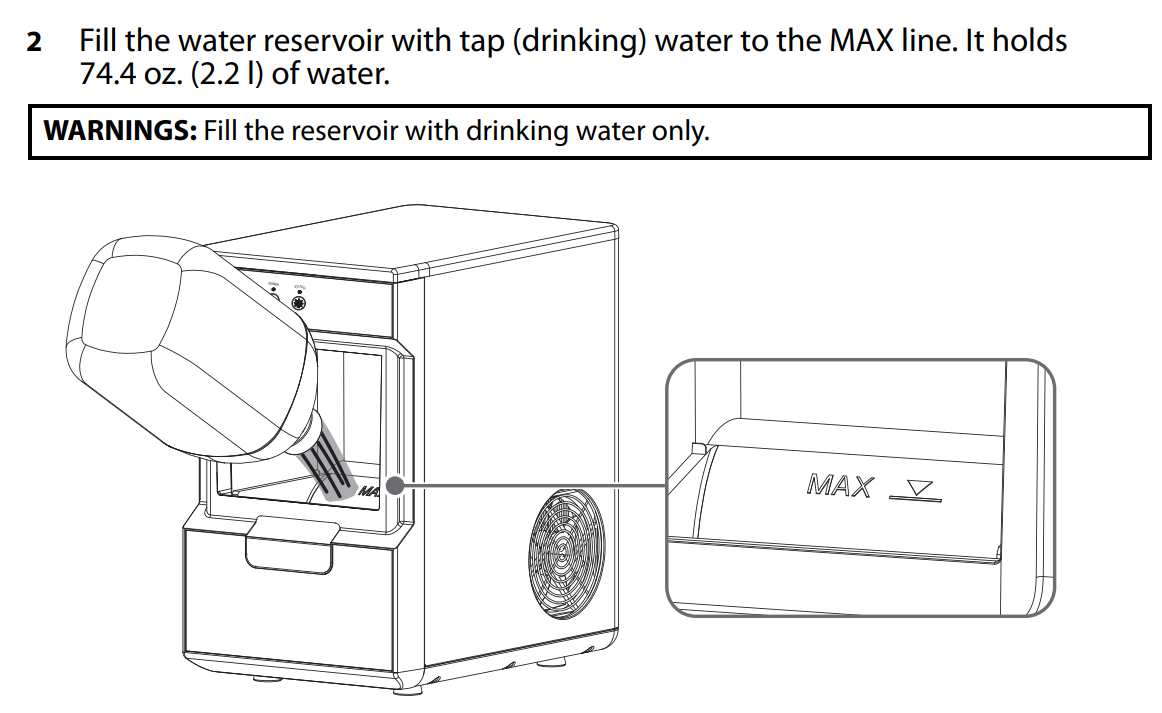
Under normal operation if you fill the ice maker when both chambers are empty and turn it on, the ice marker pumps some of the water into the upper chamber and starts making ice. As the system is closed water is never drained, if you turn the ice maker off when the tray is full of ice, then allow all of the ice to melt, the water would only ever fill back to the "max" line.
The problem with this system is that it doesn't have a second line for the amount of water possibly contained in both the upper chamber, and as nugget ice in the tray. So if you have the ice maker running and full of ice, fill to the "max" line, and turn the ice maker off the ice will melt and overflow from the reservoir around the ice maker.
So far I've had this happen once, and it's not the end of the world but it is obviously inconvenient. As a future improvement it would be nice if there was a secondary "max" line to show where you can fill the main reservoir to if the ice maker was already running and the tray completely full of ice as a worst case scenario.
Placement
The Insignia is portable in the sense that you can set it up without a water line, but weighing in at 34.4 lbs (15.6 kg) empty it's not something you'll want to move often.
The silicone tubing on the back connected to the drain plugs allow you to drain the ice maker into a large container, and you can fill it from the front. However, due to the fact that the ice is always melting when you remove the tray to fill it with water there is a considerable amount of water that ends up in front of the icemaker and under wherever the tray is placed.
In general, I would recommend the home for this appliance someplace you don't mind getting wet from general cleaning and use both on the flooring near it and counter or table where it resides. It's not unreasonable to put it away from a sink, however for convenience that's currently where mine is living as it makes filling, draining, and cleaning the ice maker more convenient.
Another consideration is that the ice maker requires requires 6 inches on both sides and the back of the unit, so when measuring for placement ensure to include this as it won't be able to sit flush with a wall or other barrier for proper airflow.
When designating a space for the ice maker it's important to note that beyond its size (H: 16.5 in, W: 9.81 in, D: 15 inches) [H: 41.91 cm, W: 24.92 cm, D: 38.1 cm] you will also require space for the plastic tray at the front. The tray slides under the Insignia, but ~3.35 in (8.5 cm) of the drip tray will stick out in front of the unit. When buying the ice maker I was under the impression that the drip tray was an optional accessory, but it is definitely required for normal operation. No matter what state the ice maker is in, when you pull out the ice tray it will drip from the melting ice and occasionally ice cubes may even fall through the cracks.
Energy Consumption
If you look online you'll find many baseless estimates suggesting that ice makers will cost you $10-$21 per month, assuming a cost of ~$0.06/KWh. This estimate comes from simply taking the Wattage of the ice maker and estimated Amps and seemingly assuming the ice maker is always making ice. This is incorrect for several reasons:
- While you may have an ice maker always "on", it's not always making ice. The Insignia will occasionally pause when making ice (presumably to let the compressor system cool off)
- The ice maker will turn off when the ice tray is determined to be full by the sensor.
- You may decide to not always have the ice maker on if you aren't home
So how much does it cost to run?
An important aspect of the ice maker to remember here is the ice it creates is always melting when left in the tray. When the ice maker is turned 'on' and left to its own devices the ice tray will eventually fill with ice and the "Ice Full" indicator will come and the device will pause. After some time the ice will melt enough that the ice maker will turn back on as it no longer sees "ice full".
I've tested the ice maker with a smart outlet, and found for the ice maker to keep replenishing ice that is melting ("steady state") takes 0.4267 kWH of electricity for 12 hours. An important item to note is that this is after the ice maker makes its first batch of ice. With this measurement I found the ice maker would take 0.8534 kWh/day and 25.97 kWh/mo, using the average of 30.437 days/month. For the state I'm currently in, this cost comes down to $4.84/mo if you turned on the ice maker and left it on and never withdrew ice from it at 0.1864 $/kWh.
Real-world use
For my current holdhouse (2 people), I've found the monthly total cost to be $5.29/month so far. For a week, the use and costs can be seen in this graph:
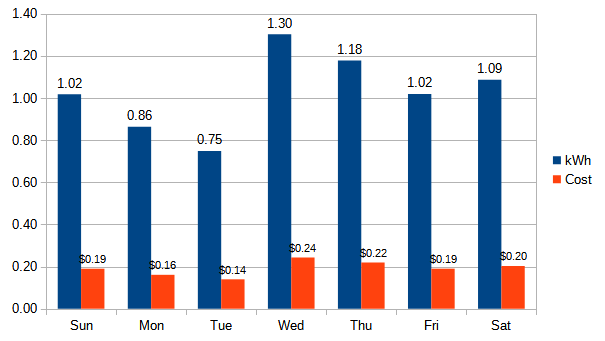
Needless to say, this is a large variance with the cost of "up to $21/mo" which was all I could find before purchasing the Insignia.
Note that this will vary based on how much ice you consume and how you approach the "always melting" part of the Insignia. Personally, I turn it off at night when I know I won't be using any more of the ice in the tray or if I know I won't be home for a while. It's hard to say exactly where the cutoff for energy savings is between the unit being off and the ice melting away or the unit being on and the ice being replaced. It would be nice if you could schedule it making ice on an app or with another system like the GE Opal lets you, but I figure the price differences between the GE and Insignia more than makes up whatever theoretical energy savings and convenience that may get you.
Noise
The ice maker doesn't make as much noise as I expected after reading some reviews on the store page, but it does make more noise than your refrigerator does. The unit utilizes both a medium sized fan on the side and the actual mechanism for the ice contributes to the noise level. The ice falling into the tray makes a varying amount of noise, from its loudest when the tray is empty and barely any noise if its full of ice as the rest of the ice cushions the new ices fall.
Overall, I'd put the noise level of the unit somewhere between a refrigerator and an air fryer with the intermittent sound of ice falling into a tray but I quickly tuned it out and it does not bother me at all.
Storage
If you're planning on storing the ice maker when not in use there are a few items to keep in mind:
- The ice maker is somewhat heavy as previously stated, so moving it from storage to its area will be inconvenient.
- The ice maker needs to stay upright in order to avoid the refrigerant from going back into the system in an unintended pathway.
- The top and bottom chambers have to be drained. I personally have my doubts you'll ever be able to fully get the upper chamber you can't access fully dry so I would have concerns draining the Insignia and setting it up for storage later. Since this isn't my use case I can't comment more of this is an actual problem you may face, but it is something to consider.
Verdict
Overall we've been happy with the ice maker so far. The energy costs ended up being substantially lower than predicted from various blogs (though I was ready to return it - I'm not willing to spend $21/mo for ice) and the ice is enjoyable to use in a variety of drinks as well as convenient to have always on hand for other applications, such as using in a cooler.
I've rated this 4 stars. It's a solid appliance, and has been performing its functions well but as cleaning is such a fundamental part of a countertop ice maker I think the lack of clarity in the cleaning section is hard to forgive. I'd also like to see a few energy saving features, such as being able to schedule it or set how much ice you want in the tray not just "full". However, it still remains a good value when compared to the price of the GE Opal series or the cheaper "bullet" ice makers as the ice is more enjoyable.
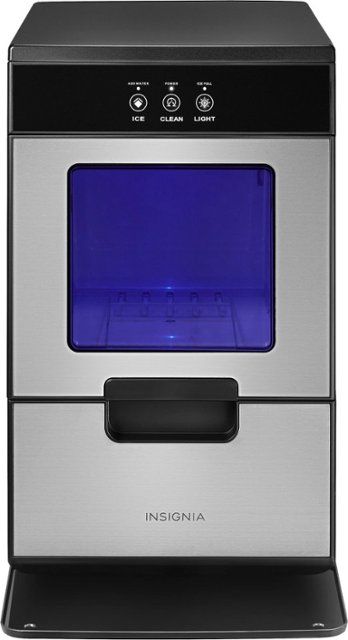
Insignia™ - 44 Lb. Portable Nugget Icemaker with Auto Shut-Off - Stainless steel
A competent countertop ice maker with a demanding yet unclear cleaning regiment

